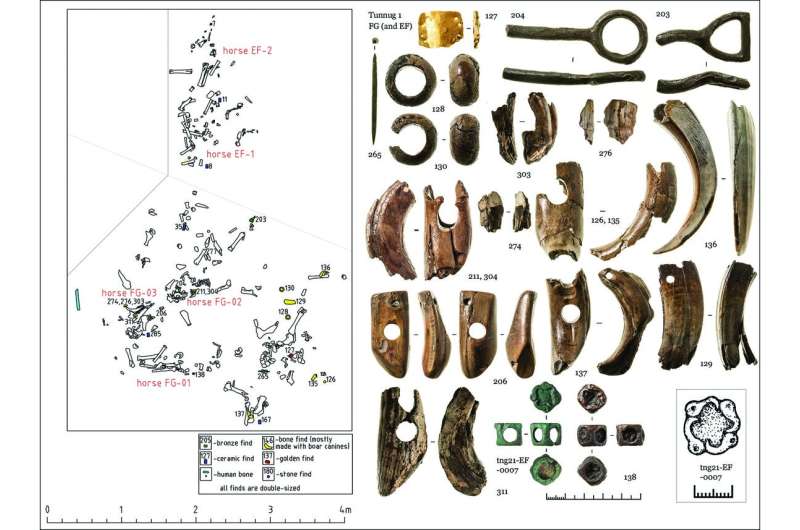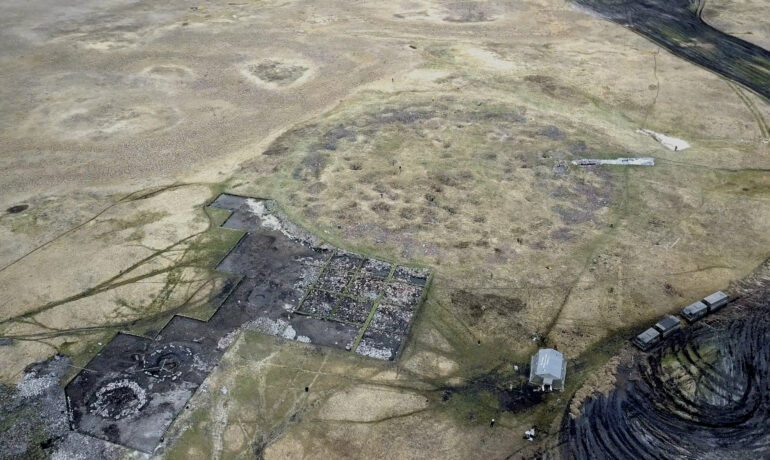Archaeologists have uncovered evidence for sacrificial funerary rituals at the Early Iron Age burial mound of Tunnug 1 in Tuva, Siberia, indicating that the horse-riding Scythian culture, best-known from Eastern Europe, originated far to the east.
The Scythians were a people of the Eurasian Steppe, famous for their horse-focused culture and distinctive ‘animal-style’ art, which depicts stylized animals in a series of specific poses.
Their mobile way of life meant that their distribution fluctuated widely over time. The Scythians are known to have migrated from Central Asia to the Pontic Steppe in modern south-west Russia and Ukraine, but their exact origins remain obscure.
“The horseback-riding Scythians have sparked the imaginations of people since the days of Herodotus,” says senior author of the research, Dr. Gino Caspari from the Max Planck Institute of Geoanthropology and the University of Bern. “But the origins of their culture have long remained hidden in remote corners of the Eurasian steppes.”
To track down the Scythians’ elusive beginnings, a team of researchers from several institutions surveyed one of the earliest examples of a royal burial mound containing Scythian material culture; the late-ninth-century-BC kurgan of Tunnug 1 in Tuva, southern Siberia. Their results are published in the journal Antiquity.

Finds from Tunnug 1. © Antiquity, https://doi.org/10.15184/aqy.2024.145
The fragmented remains of at least one human and 18 horses were discovered on the mound, suggesting they were sacrificed in honor of the elite individual buried within.
The bones were found in association with Scythian animal-style artifacts and horse-riding equipment, indicating the burial is an early example of the horse-focused funerary rituals of the later Scythians, described thousands of kilometers to the west in Classical texts.
“After years of tough fieldwork in Siberia, it is just wonderful to hold some of the oldest Scythian animal-style items in our hands,” states Dr. Caspari. “Unearthing some of the earliest evidence of a unique cultural phenomenon is a privilege and a childhood dream come true.”
The presence of “Scythian-style” burials as far east as Tuva suggests the origins of Scythian culture, which have so long been mired in obscurity, lie on the other side of the Eurasian steppe, highlighting the mobility of early horse-cultures.
Furthermore, the burial also shares many similarities with examples from the Late Bronze Age in Mongolia. This suggests that parts of the Scythians’ funerary rituals originate even further east and south, with the Bronze Age horse cultures of Mongolia.
“The evidence from Tunnug 1 solidifies the crucial role Tuva plays in Eurasian prehistory,” Dr. Caspari concludes. “Our findings highlight the importance of Inner Asia in the development of transcontinental cultural connections. The findings also suggest that these funerary practices played a role in the broader process of cultural and political transformation across Eurasia, contributing to the emergence of later pastoralist empires.”
More information:
A spectral cavalcade: Early Iron Age horse sacrifice at a royal tomb in southern Siberia. Antiquity (2024). doi.org/10.15184/aqy.2024.145
Citation:
Sacrificial burial confirms Scythians’ eastern origins (2024, October 7)



